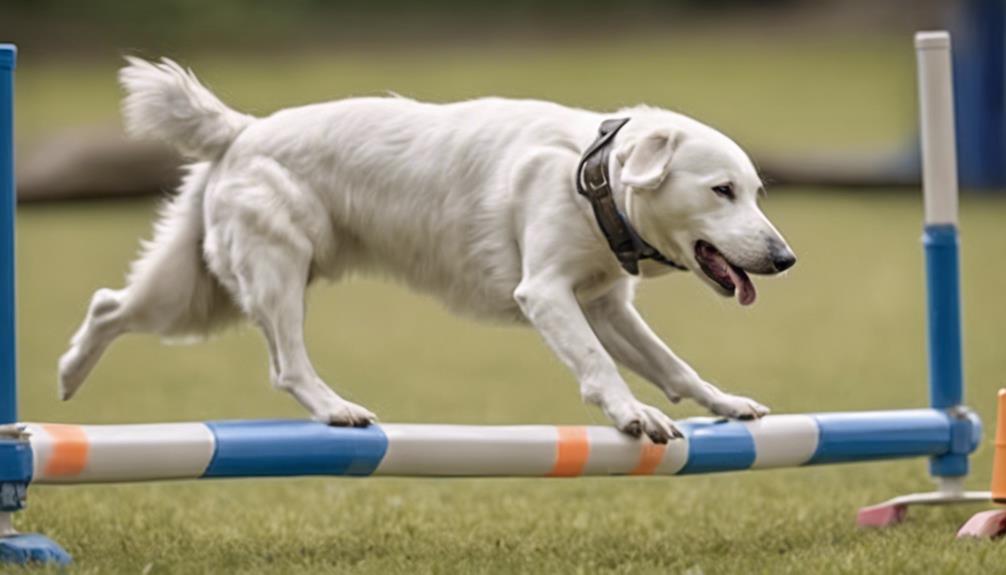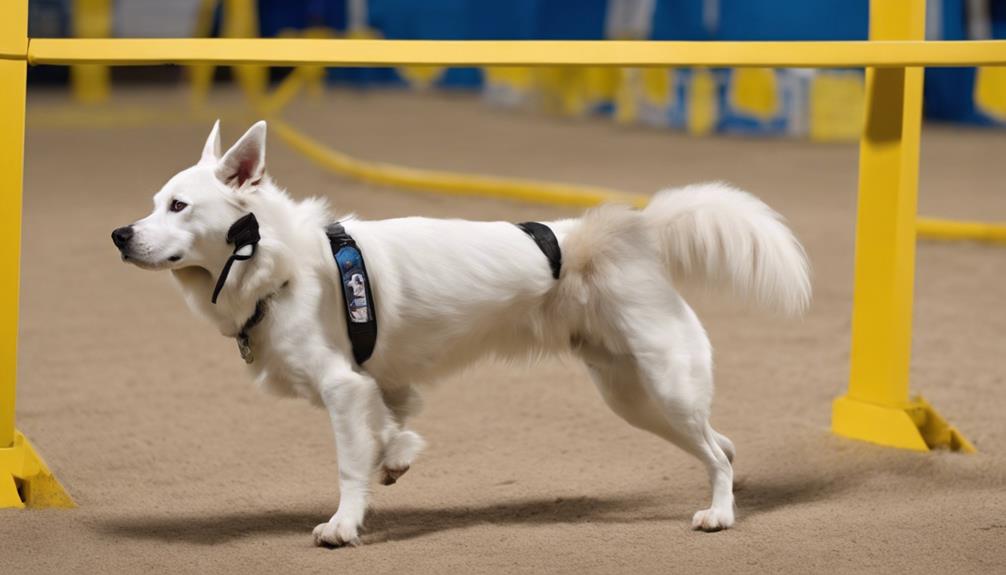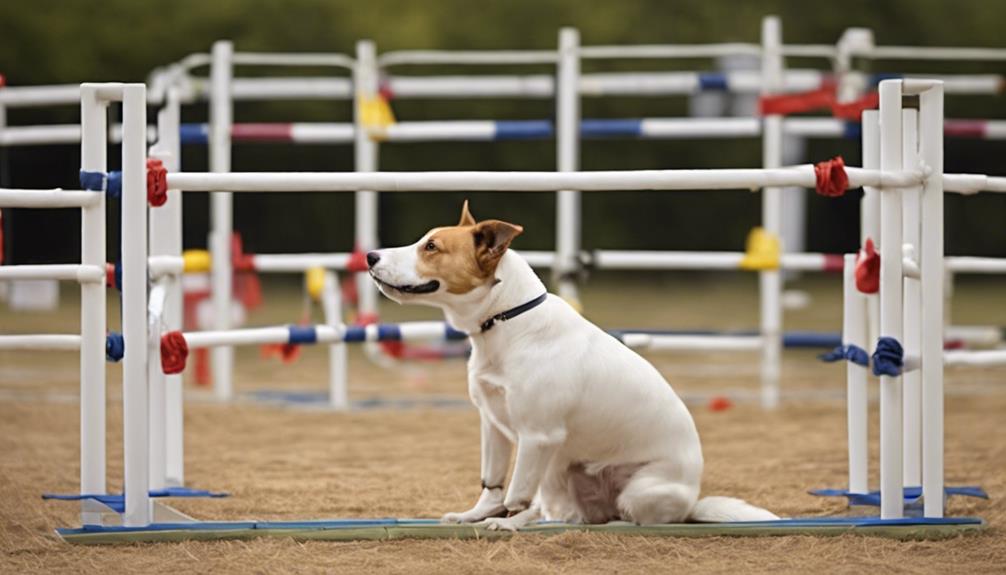In the realm of teaching deaf dogs, hand gestures serve as the vital keys to unveiling a secret language shared between us and our beloved pets.
But what truly makes a trainer effective in this unique realm goes beyond just gestures; it delves into the art of building trust, understanding behavior, and mastering the intricacies of visual communication.
Let's explore the nuances and expertise required to navigate this silent yet profound journey with our deaf canine friends.
Key Takeaways
- Utilize visual cues and hand signals for clear communication and training success.
- Build trust through consistency, patience, and positive reinforcement techniques.
- Incorporate clicker training and consistent schedules for effective behavior shaping.
- Provide enrichment through socialization, varied environments, and mental stimulation activities.
Understanding Deaf Dog Behavior
Understanding deaf dog behavior requires a keen awareness of their reliance on visual and tactile cues for communication and learning. Training deaf dogs involves adapting traditional methods to focus on visual cues and positive reinforcement.
Since they can't rely on verbal commands, trainers utilize hand signals and body language to communicate effectively. This shift in training methods emphasizes the importance of clear and consistent visual cues.
Deaf dogs excel in environments where visual signals are prominent, making training sessions more efficient when utilizing gestures and signals. Incorporating visual cues into obedience training helps deaf dogs understand expectations and commands.
Importance of Visual Communication

Visual communication plays a pivotal role in the successful training and interaction with deaf dogs due to their reliance on non-verbal cues. Deaf dogs heavily depend on visual signals, such as hand gestures, to understand commands and information effectively. Clear and consistent visual cues are essential for deaf dogs to grasp training instructions and respond appropriately. By utilizing visual communication, trainers can bridge the communication gap caused by deafness in dogs, leading to improved training outcomes and a stronger bond between the trainer and the dog.
Since deaf dogs can't rely on auditory cues, visual communication becomes the primary mode of conveying information and building trust. The use of visual cues not only aids in training but also enhances the overall relationship between the trainer and the deaf dog. Through innovative approaches that emphasize visual signals, trainers can establish a clear means of communication that's tailored to the unique needs of deaf dogs, facilitating successful training sessions and fostering a deeper connection.
Establishing Trust and Connection
Establishing trust and connection with a deaf dog involves consistent positive interactions that utilize visual cues for effective communication. Training deaf dogs requires special attention to visual cues, as they rely on these signals to understand commands and behaviors. By incorporating visual cues into training sessions, trainers can bridge the communication gap and build a strong foundation of trust with their deaf canine companions.
Understanding the unique needs of deaf dogs is crucial in forming a deep connection. Patience, observation of body language, and respect for boundaries are key components in earning a deaf dog's trust. Routine and predictability play a significant role in creating a secure bond with these animals, as it helps them feel safe and supported during training.
Utilizing touch cues and rewards can further enhance the bond between a deaf dog and their trainer. These positive reinforcements not only strengthen trust but also motivate the dog to actively participate in training exercises. Ultimately, establishing trust and connection is fundamental for successful training outcomes and fostering a harmonious relationship between the deaf dog and their trainer.
Hand Signals for Training Success

Hand signals serve as the cornerstone of successful training for deaf dogs, offering a reliable means of communication that fosters understanding and responsiveness to commands and cues. When utilizing hand signals in training techniques, it's crucial to ensure they're consistent, clear, and easily distinguishable. Deaf dogs rely on visual cues to comprehend instructions, making the clarity of hand signals paramount for effective communication. By incorporating precise hand signals into training sessions, trainers can promote focus, engagement, and successful learning outcomes for their deaf canine companions.
Consistency in using hand signals helps deaf dogs understand and respond to various commands and cues with accuracy. This consistency reinforces positive behaviors and strengthens the bond between the trainer and the deaf dog. Clear and distinct hand signals not only facilitate communication but also reduce confusion during training sessions, leading to more efficient learning experiences. When executed properly, hand signals can significantly enhance the training process for deaf dogs, paving the way for improved obedience and heightened interaction between trainer and pet.
Positive Reinforcement Techniques
Utilizing positive reinforcement techniques is a proven method for effectively shaping desired behaviors in deaf dogs through the strategic use of rewards. Positive reinforcement involves rewarding deaf dogs with treats or toys when they exhibit desirable behaviors, encouraging them to repeat those actions. Incorporating a clicker to mark good behaviors can further reinforce positive actions in training a deaf dog. Consistency in training schedules is paramount to promote learning and progress in deaf dogs, as they rely heavily on routine. It is essential to avoid punitive training methods and instead focus on patience and positive reinforcement to achieve successful training outcomes with deaf dogs. By using positive reinforcement techniques, a strong bond can be built between the trainer and the deaf dog, enhancing communication and trust.
| Rewards | Benefits |
|---|---|
| Treats or toys | Encourages repetition of desired behaviors |
| Clicker | Reinforces positive actions effectively |
| Consistent schedule | Promotes learning and progress in deaf dogs |
| Patience | Key to successful training outcomes |
| Bond building | Enhances communication and trust between trainer and deaf dog |
Addressing Behavioral Challenges

How can behavioral challenges in deaf dogs be effectively addressed? Deaf dogs may face issues such as separation anxiety, communication barriers, and socialization difficulties. When tackling these challenges, training techniques specific to deaf dogs are essential. Utilizing positive reinforcement, establishing consistent routines, and employing clear communication methods are key strategies. To address fear-based behaviors, patience, desensitization, and trust-building exercises through positive interactions are crucial.
Understanding the root causes of behavioral challenges is fundamental for deaf dog trainers. By tailoring training methods to each dog's specific needs, trainers can effectively address and modify unwanted behaviors. Seeking professional guidance and support can also be beneficial in creating personalized strategies to tackle behavioral issues in deaf dogs.
Innovative approaches that combine traditional training methods with specialized techniques for deaf dogs can yield positive results. By focusing on empathy, creativity, and a deep understanding of canine behavior, trainers can navigate and overcome the behavioral challenges faced by deaf dogs effectively.
Building Confidence in Deaf Dogs

To enhance the well-being and behavior of deaf dogs, fostering confidence through positive reinforcement techniques is paramount. Building confidence in deaf dogs involves creating a positive and supportive environment where desired behaviors are encouraged and rewarded. Positive reinforcement, such as treats, toys, or praise, can help deaf dogs associate good behavior with positive outcomes, boosting their self-assurance.
Providing a safe and secure space for deaf dogs is crucial in helping them feel more confident and less anxious. Gradual exposure to new experiences and environments can also play a significant role in building a deaf dog's confidence over time. Consistent training routines and clear communication methods are essential in enhancing a deaf dog's self-assurance. Celebrating small victories and progress with rewards can further increase a deaf dog's confidence levels, reinforcing positive behaviors and strengthening the bond between the dog and its trainer.
Effective Recall Strategies

When training deaf dogs for effective recall, consistency in using hand signals or visual cues is key to reinforcing positive behavior. Deaf dogs rely on these cues to understand commands, making them crucial in recall training.
Incorporating high-value rewards or treats further strengthens the desired behavior. By associating the hand signal with a rewarding outcome, deaf dogs are motivated to respond promptly when called.
It's essential to practice recall training in various environments to generalize the behavior, ensuring that the dog can recall reliably regardless of the setting. Starting in a low-distraction environment and gradually increasing distractions helps build a strong foundation for recall.
Additionally, fostering a strong bond with your deaf dog enhances the effectiveness of recall training, as trust and communication are fundamental in this process. Consistent use of hand signals and positive reinforcement sets the stage for successful recall training in deaf dogs.
Socialization Strategies for Deaf Dogs

Socialization plays a vital role in helping deaf dogs acclimate to different environments and interact confidently with others. By utilizing canine playgroups, visual cues for training, and exposure to a variety of environments, we can create positive experiences that build their social skills.
This approach, coupled with positive reinforcement, can help deaf dogs develop into well-adjusted companions capable of navigating various social situations with ease.
Canine Playgroups for Socialization
Canine playgroups play a vital role in fostering socialization skills and positive interactions for deaf dogs. These groups offer a safe environment for deaf dogs to interact with others, enhancing their ability to understand appropriate behaviors and body language cues.
By engaging with a diverse range of dogs, deaf dogs can build confidence and improve their communication skills. The structured setting of playgroups allows deaf dogs to practice social skills and form positive relationships with their canine counterparts.
Proper supervision in these settings not only promotes mental stimulation but also provides essential physical exercise, contributing to the overall well-being of deaf dogs. Participating in playgroups can significantly benefit deaf dogs by improving their socialization and overall quality of life.
Visual Cues for Training
Utilizing visual cues is paramount in effectively training deaf dogs, given their reliance on sight for communication. When training a deaf dog, incorporating visual cues can significantly enhance the learning process. Here are three key strategies to train a deaf dog using visual cues:
- Consistent hand gestures: Using consistent hand signals for commands helps deaf dogs understand and respond appropriately.
- Visual tools: Tools like flashlights or vibrating collars can aid in signaling commands over longer distances, improving communication during training sessions.
- Adequate lighting: Good lighting conditions are crucial for clear visibility when using visual cues with deaf dogs, ensuring effective communication and understanding.
Exposure to Different Environments
Exposing deaf dogs to a variety of environments plays a crucial role in their socialization and overall development. Socialization strategies for deaf dogs should encompass exposure to diverse settings, people, and animals early on. Introducing them to various sounds, textures, and experiences aids in their adaptability and confidence. Positive interactions in different environments help deaf dogs in developing social skills and reducing anxiety. Controlled introductions to new stimuli are essential to prevent fear or aggression responses during socialization. Monitoring the deaf dog's comfort levels during gradual exposure to different environments is key for successful socialization.
| Strategies for Exposure to Different Environments | |
|---|---|
| Early introduction to diverse settings | Introducing various sounds, textures, experiences |
| Positive interactions in different environments | Controlled introductions to new stimuli |
| Monitoring comfort levels during exposure |
Agility Training for Deaf Dogs

When training deaf dogs in agility, adapting courses with visual cues and tactile signals is essential for effective navigation through obstacles. Using treats as rewards for completing tasks can also be a useful method to motivate and communicate with deaf dogs during agility training sessions.
- Incorporate hand signals and gestures: Utilize clear hand signals and gestures to guide the deaf dog through the agility course.
- Implement ground vibrations: Establish specific ground vibrations to signal different actions or directions to the deaf dog.
- Use light cues: Integrate light cues strategically placed throughout the course to direct the deaf dog's movements accurately.
These innovative techniques enhance the training experience for deaf dogs, allowing them to participate fully in agility courses. By focusing on visual and tactile communication methods, trainers can help deaf dogs excel in agility training, showcasing their intelligence and agility in a unique and enriching way.
Enrichment Activities for Deaf Dogs

When it comes to enriching the lives of deaf dogs, sensory stimulation games and visual cue training are essential components.
These activities not only provide mental engagement but also help deaf dogs navigate their world effectively.
Incorporating such enrichment activities can lead to a happier and more fulfilled life for our furry companions.
Sensory Stimulation Games
Engaging a deaf dog in sensory stimulation games is a beneficial way to enhance their mental acuity and prevent boredom while promoting their overall well-being. These activities focus on engaging their other senses like smell, touch, and sight, providing mental enrichment beyond auditory stimuli.
Some examples of sensory stimulation games for deaf dogs include:
- Scent work: Engaging the dog's sense of smell through activities like hiding treats or toys for them to find.
- Puzzle toys: Toys that require the dog to solve a puzzle to access a treat, stimulating their problem-solving skills.
- Tactile games: Activities that involve textures and touch, such as different surfaces for the dog to explore with their paws or nose.
Visual Cue Training
Visual cue training is an essential component of enrichment activities for deaf dogs, stimulating their cognitive abilities through the use of non-auditory signals. Deaf dogs rely heavily on visual cues like hand signals or light signals to communicate, making it crucial to incorporate these cues into their training routines.
By engaging a deaf dog's attention through visual cues, trainers can effectively teach new commands and behaviors. Furthermore, the consistent use of visual cues in enrichment activities not only enhances the bond between the owner and the deaf dog but also provides mental stimulation that prevents boredom.
Interactive games that incorporate visual cues offer a fun and engaging way to reinforce desired behaviors, ultimately contributing to the overall well-being of deaf dogs.
Addressing Separation Anxiety

Deaf dog trainers employ specialized techniques to effectively address separation anxiety in their canine companions, focusing on building independence and confidence. Deaf dogs, relying heavily on visual and tactile cues for communication, are more prone to separation anxiety, which can lead to destructive behaviors and self-harm.
To help deaf dogs overcome separation anxiety, trainers implement innovative methods such as:
- Providing interactive toys: Engaging toys can help distract deaf dogs and keep them mentally stimulated while their owners are away.
- Creating a safe space: Establishing a designated area within the home where the dog feels secure and comfortable can reduce anxiety during separations.
- Gradual desensitization: Slowly exposing the deaf dog to short periods of alone time and gradually increasing the duration can help build their confidence and independence.
Training for Good Leash Manners

When training for good leash manners in deaf dogs, it's essential to focus on leash handling techniques, positive reinforcement methods, and a consistent practice regimen.
Visual cues and hand signals can effectively convey expectations to the dog during walks.
Leash Handling Techniques
Proper leash handling techniques play a crucial role in instilling good leash manners in dogs, particularly those who are deaf. When working with deaf dogs, visual cues become paramount for effective communication during walks.
Here are some key techniques to consider:
- Use a sturdy, comfortable leash to maintain control and facilitate communication with your deaf dog.
- Avoid jerking or pulling on the leash to prevent unsettling and confusing experiences for your deaf dog.
- Practice loose leash walking to encourage your deaf dog to stay beside you without experiencing tension on the leash.
Positive Reinforcement Methods
Utilizing positive reinforcement methods is a highly effective approach for training deaf dogs to exhibit good leash manners during walks. Rewarding a deaf dog with treats or toys when they display desired leash behaviors reinforces the calm walking conduct.
Consistency in rewarding these behaviors helps deaf dogs understand what's expected of them and encourages them to repeat the actions. Clicker training can also be beneficial in marking the precise moment the dog demonstrates good leash manners.
Consistent Practice Regimen
Consistent practice plays a crucial role in shaping a deaf dog's leash manners, laying the foundation for effective leash training. Regular training sessions are essential for reinforcing desired behaviors on the leash.
By repeating leash training exercises, a strong foundation for walking can be built, ensuring that the deaf dog understands proper leash etiquette. Consistency in training methods is key to helping the dog learn and maintain good leash manners.
Gradual progression in the training program is also important as it allows the deaf dog to learn to walk politely on a leash, ultimately leading to successful leash manners.
Teaching Watch Me Cue

To effectively teach the 'Watch Me' cue to a deaf dog, establish a clear visual signal or hand gesture for capturing their attention. Using consistent teaching hand signals or visual cues helps in communicating effectively with your deaf dog. Here is a table illustrating some common hand gestures used for the 'Watch Me' cue:
| Hand Gesture | Description | Usage |
|---|---|---|
| Pointing Finger | Point towards your eyes | Direct your dog's attention to you |
| Open Palm | Show your open palm facing your dog | Signal your dog to focus on you |
| Tap on Shoulder | Gently tap your shoulder where your dog can see | Prompt your dog to look at you |
| Two Fingers to Eyes | Place two fingers on your eyes | Encourage eye contact with your dog |
| Waving Hand | Wave your hand in front of your face | Attract your dog's attention to you |
Reward your deaf dog for responding to these visual cues with eye contact, reinforcing the behavior positively. Practice these signals consistently in different environments to improve your dog's responsiveness and understanding of the 'Watch Me' cue.
Advanced Training Techniques

Exploring advanced training techniques for deaf dogs involves tapping into their natural abilities and enhancing their skills through specialized methods such as scent training and touch cues.
Incorporating touch cues in advanced training can help deaf dogs navigate complex tasks with precision and confidence.
Additionally, using visual cues for shaping behaviors like agility or obedience can challenge and stimulate deaf dogs mentally and physically.
Reward-based training is particularly effective in advanced training, as it reinforces positive behaviors and strengthens the bond between the dog and the trainer.
These techniques not only improve the deaf dog's skills but also foster a deeper understanding and communication between the dog and its owner.
Professional trainers experienced in working with deaf dogs can provide tailored advanced training programs that cater to the unique needs and abilities of these special animals.
Frequently Asked Questions
How Do You Train a Deaf Dog?
When training a deaf dog, we rely on visual cues, hand signals, and tactile cues for effective communication. Positive reinforcement, like rewards and treats, is essential for success.
Consistency, patience, and repetition play crucial roles in the training process. Incorporating mark and reward methods, such as clicker training with gestures, can reinforce desired behaviors.
Startle training techniques help desensitize deaf dogs to unexpected touch stimuli and encourage positive reactions.
What Training Tools Are Used for Deaf Dogs?
We utilize various tools in training deaf dogs. These include:
- Vibrating collars for tactile cues
- Flashlights for visual signals
- Hand signals for commands
- Treats/toys for positive reinforcement
Consistent use of specific visual cues is vital for clear communication. These tools help establish a strong training foundation for deaf dogs, enhancing understanding and responsiveness.
Each element plays a crucial role in shaping behaviors and fostering a strong bond between trainer and canine companion.
How Do You Train a Deaf Dog Not to Jump?
When training a deaf dog not to jump, we focus on redirecting their behavior positively. Instead of reinforcing jumping by giving attention, we reward calm actions like sitting.
Visual cues can also be helpful, like stepping back when the dog jumps. Teaching a specific cue for grounding all four paws further reinforces the desired behavior.
Consistency and patience are key in helping deaf dogs understand and adopt new behaviors effectively.
How Do You Train a Deaf Dog Not to Pee in the House?
We train our deaf dog not to pee in the house by establishing a consistent routine for potty breaks. We use visual cues to signal bathroom time and closely monitor for signs of needing to go outside. Rewarding with treats or praise for eliminating outside and promptly cleaning up accidents with an enzymatic cleaner are also important techniques.
These methods reinforce desired behavior and help prevent accidents indoors. Consistency and positive reinforcement are key in house training a deaf dog.
Conclusion
In conclusion, utilizing effective deaf dog trainer techniques, such as visual communication and positive reinforcement, can greatly enhance the training process for deaf dogs.
By establishing trust, using hand signals, and addressing specific behaviors like separation anxiety and leash manners, we can create a strong bond with our canine companions.
With patience and consistency, we can unlock the potential of deaf dogs and help them thrive in their training journey.
Training deaf dogs is like painting a masterpiece with our hands, creating a beautiful and harmonious connection.











